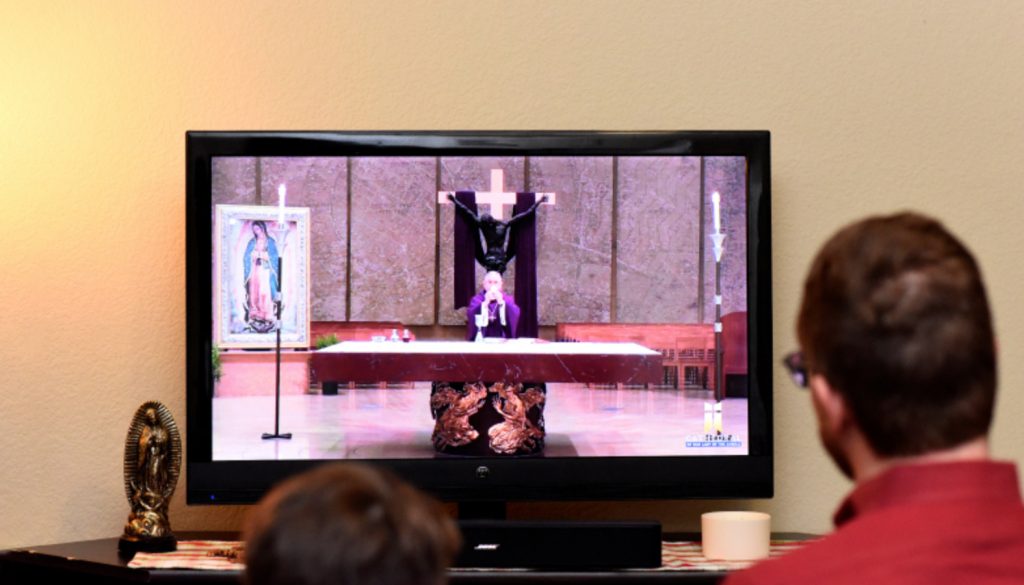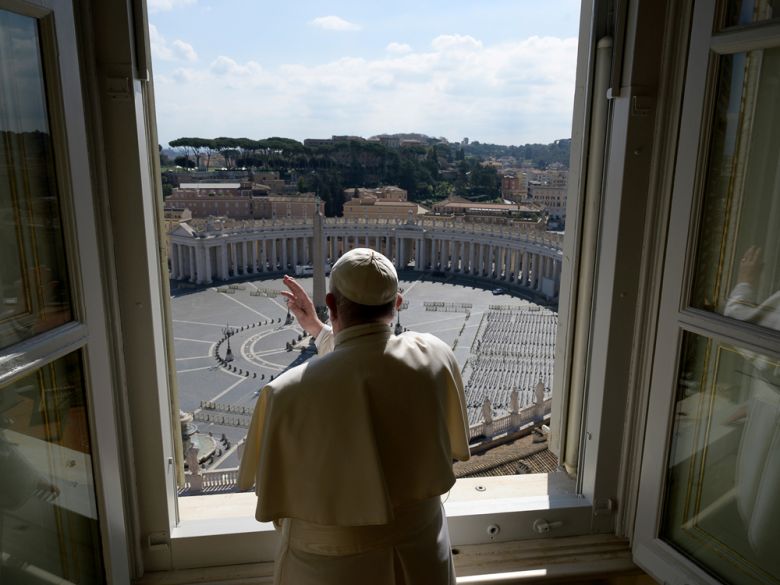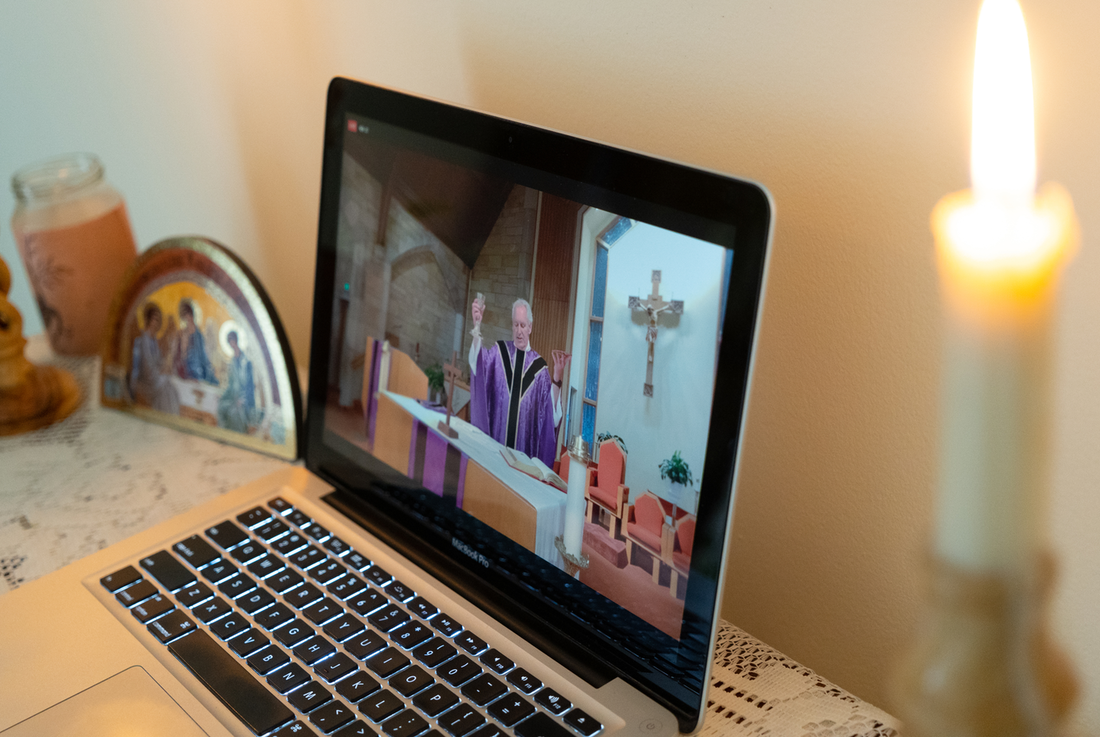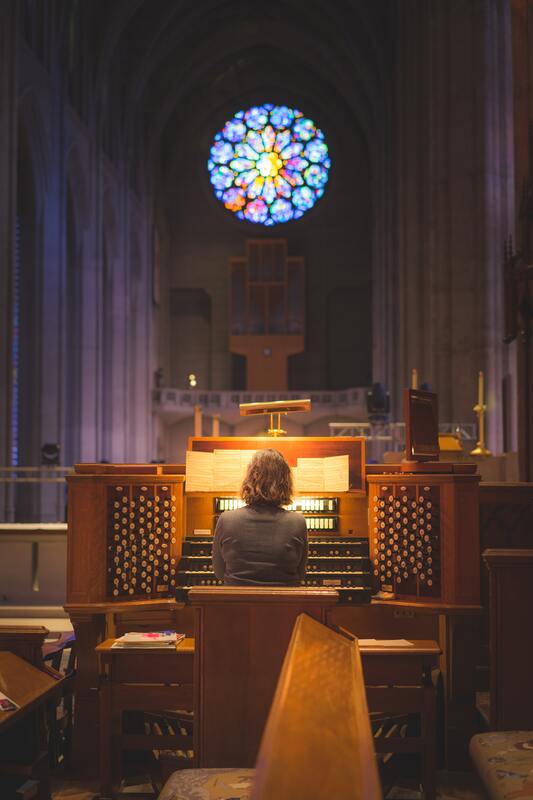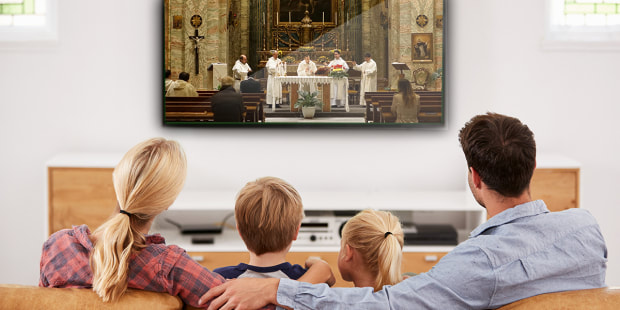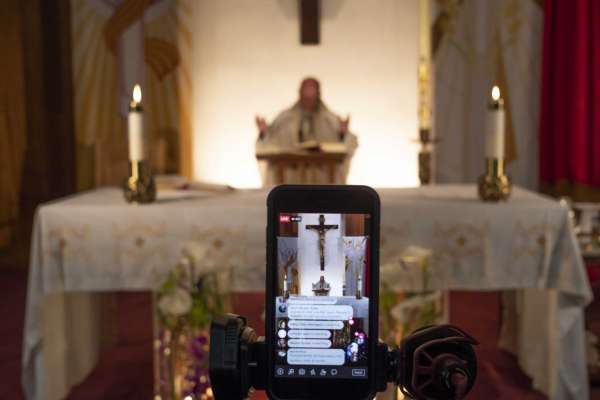Real Presence and Virtual Liturgies
by Felix Just SJ
The coronavirus pandemic, tragic as it is, is also inspiring pastoral reflection and theological debates that will hopefully bring the Church to deeper insights and renewed practices. One current topic of heated discussion is the "virtual" celebration of the Eucharist, and the related question of about what is "real."
In a recent article in La Croix International, J.P. Grayland astutely asks, "Is the quality of my digital presence of the exact same quality as my physical presence?"
My answer: No, they are not exactly the same; yet this does not mean that one type of "presence" is "real" while the other is "not real."
Shortly later, in asking whether a "digital solution" is appropriate for our celebration of the Eucharist, Grayland says, "The answer depends on how one understands reality, the virtual and presence. What distinguishes 'virtual reality' from 'real-reality' or 'virtual presence' from 'real presence' and makes one proper for the celebration of the Eucharist and the other not?"
Here Grayland slips into a false dichotomy, now opposing "virtual" vs. "real," when the difference is actually between "virtual reality" and "physical reality." Both are "real," although in different ways. To avoid such false oppositions, we need greater terminological precision and philosophical nuance. The best of Catholic theology avoids simplistic divisions: yes or no, all or nothing, presence or absence, reality or non-reality.
In his most recent "Letter from Rome," Robert Mickens similarly seems to assume that the only "real presence" is "physical presence." He writes, "Let's be clear: we cannot really 'participate' in a virtual Mass any more than we can share a virtual handshake, hug or kiss. Some things demand real presence. It's amazing how many Catholic priests and people seem to have forgotten this."
I beg to differ. Yes, one can share a "virtual handshake, hug or kiss." Obviously, the various virtual versions of such greetings are not quite the same (or nearly as satisfying!) as their physical equivalents; but isn't a virtual greeting (in whatever form it takes) better than the opposite (a virtual slap, thumbs down, or middle finger)?
Doesn't a virtual greeting still connect people in a very real and significant way?
In a recent article in La Croix International, J.P. Grayland astutely asks, "Is the quality of my digital presence of the exact same quality as my physical presence?"
My answer: No, they are not exactly the same; yet this does not mean that one type of "presence" is "real" while the other is "not real."
Shortly later, in asking whether a "digital solution" is appropriate for our celebration of the Eucharist, Grayland says, "The answer depends on how one understands reality, the virtual and presence. What distinguishes 'virtual reality' from 'real-reality' or 'virtual presence' from 'real presence' and makes one proper for the celebration of the Eucharist and the other not?"
Here Grayland slips into a false dichotomy, now opposing "virtual" vs. "real," when the difference is actually between "virtual reality" and "physical reality." Both are "real," although in different ways. To avoid such false oppositions, we need greater terminological precision and philosophical nuance. The best of Catholic theology avoids simplistic divisions: yes or no, all or nothing, presence or absence, reality or non-reality.
In his most recent "Letter from Rome," Robert Mickens similarly seems to assume that the only "real presence" is "physical presence." He writes, "Let's be clear: we cannot really 'participate' in a virtual Mass any more than we can share a virtual handshake, hug or kiss. Some things demand real presence. It's amazing how many Catholic priests and people seem to have forgotten this."
I beg to differ. Yes, one can share a "virtual handshake, hug or kiss." Obviously, the various virtual versions of such greetings are not quite the same (or nearly as satisfying!) as their physical equivalents; but isn't a virtual greeting (in whatever form it takes) better than the opposite (a virtual slap, thumbs down, or middle finger)?
Doesn't a virtual greeting still connect people in a very real and significant way?
"Real Presence" is not just "Physical Presence"
Although I agree with both authors that "some things demand real presence," it's essential to understand that "real presence" is not the same as, nor limited to, "physical presence."
Just as there are different kinds of "reality," so also there are different types or modes of "presence." Not all "reality" is physical; there are also spiritual realities, sacramental realities, virtual realities, etc.
To understand how real something virtual/digital can be, just consider the phenomenon of cyber-bullying, which can cause very real damage, not just to teenagers but also to adults!
Similarly, not all "presence" necessarily requires physical proximity; one can be present to other people in a very real sense even when using the telephone, the computer, or other modern audio-visual and tele-conferencing technology, which allow us to connect with others who are physically distant.
This is already a commonplace for legal proceedings in many jurisdictions. Although these modes of "digital presence" are not exactly the same as being in the same location at the same time, they still allow people to connect, to "gather," and to be "present to one another" in very real ways.
Jesus assured his disciples, "For where two or three are gathered together in my name, there am I in the midst of them" (Matt 18:20 NAB). For centuries, and even today, most people would think "gathered" means they must be "physically together in the same place at the same time."
But is that really necessary? If two or three Christians pray together while on the telephone, wouldn't we say that Christ is also present with them? Or if hundreds of people are "gathered virtually" for a live-streamed Mass or watching the Pope's Urbi et Orbi blessings, wouldn't we still want to say that Christ is truly, really present with them?
In the case of the Urbi et Orbi, the Church has long taught that this blessing reaches out not only to those who are physically gathered in St. Peter's Square, nor just to people in Rome, but rather that it extends to all people throughout the world.
Moreover, with the invention of radio, television, and digital media, the Church has even said that it goes out even to those who hear the blessing rebroadcast later from an audio or video recording. So the "real effect" of such a blessing is limited neither by physical proximity nor by temporal simultaneity.
Although I agree with both authors that "some things demand real presence," it's essential to understand that "real presence" is not the same as, nor limited to, "physical presence."
Just as there are different kinds of "reality," so also there are different types or modes of "presence." Not all "reality" is physical; there are also spiritual realities, sacramental realities, virtual realities, etc.
To understand how real something virtual/digital can be, just consider the phenomenon of cyber-bullying, which can cause very real damage, not just to teenagers but also to adults!
Similarly, not all "presence" necessarily requires physical proximity; one can be present to other people in a very real sense even when using the telephone, the computer, or other modern audio-visual and tele-conferencing technology, which allow us to connect with others who are physically distant.
This is already a commonplace for legal proceedings in many jurisdictions. Although these modes of "digital presence" are not exactly the same as being in the same location at the same time, they still allow people to connect, to "gather," and to be "present to one another" in very real ways.
Jesus assured his disciples, "For where two or three are gathered together in my name, there am I in the midst of them" (Matt 18:20 NAB). For centuries, and even today, most people would think "gathered" means they must be "physically together in the same place at the same time."
But is that really necessary? If two or three Christians pray together while on the telephone, wouldn't we say that Christ is also present with them? Or if hundreds of people are "gathered virtually" for a live-streamed Mass or watching the Pope's Urbi et Orbi blessings, wouldn't we still want to say that Christ is truly, really present with them?
In the case of the Urbi et Orbi, the Church has long taught that this blessing reaches out not only to those who are physically gathered in St. Peter's Square, nor just to people in Rome, but rather that it extends to all people throughout the world.
Moreover, with the invention of radio, television, and digital media, the Church has even said that it goes out even to those who hear the blessing rebroadcast later from an audio or video recording. So the "real effect" of such a blessing is limited neither by physical proximity nor by temporal simultaneity.
Being physically present and participating in a "live" Mass, if possible, is when the assembly of baptised believers most visibly forms the ecclesial Body of Christ and when they can actually receive the consecrated Body and Blood of Christ.
This manner of human connection and the reception of sacramental communion is clearly the best setting for the Eucharistic celebration.
In contrast, televised Masses are not so ideal, especially if the presider has to rush to fit a broadcast time slot and if there is little human connection between the presider and the people watching.
A live-streamed liturgy, however, can be so much more than merely "watching Mass on TV".
My own experience over the last few weeks of "sheltering in place" due to the coronavirus pandemic has shown me (and thousands of others) that it is truly possible to "participate" to a high degree and in significant ways in a live-streamed Mass.
If live-streamed liturgies are prepared carefully and celebrated well, the "virtual assembly" can participate in many important ways, despite not being physically present in the church building.
Let me describe some aspects of how live-streamed Sunday Masses are now being celebrated at St. Ignatius Church, on the campus of the University of San Francisco, which make the "virtual participation" of the assembly quite real.
This manner of human connection and the reception of sacramental communion is clearly the best setting for the Eucharistic celebration.
In contrast, televised Masses are not so ideal, especially if the presider has to rush to fit a broadcast time slot and if there is little human connection between the presider and the people watching.
A live-streamed liturgy, however, can be so much more than merely "watching Mass on TV".
My own experience over the last few weeks of "sheltering in place" due to the coronavirus pandemic has shown me (and thousands of others) that it is truly possible to "participate" to a high degree and in significant ways in a live-streamed Mass.
If live-streamed liturgies are prepared carefully and celebrated well, the "virtual assembly" can participate in many important ways, despite not being physically present in the church building.
Let me describe some aspects of how live-streamed Sunday Masses are now being celebrated at St. Ignatius Church, on the campus of the University of San Francisco, which make the "virtual participation" of the assembly quite real.
Preparing for the Liturgy
The parish website lists the schedule of live-streaming liturgies and includes prominent links for these and many other parish services available electronically.
Several days before each Sunday Mass, reminders are sent by email (or even video links) to all parishioners and others who have participated in weeks past.
Some people set up a special "sacred place" in their home—maybe with a cross, candles, flowers, icons, or other symbols—where they will gather for the Eucharist.
Some even "dress up" for church, although others might stay in their pajamas!
A worship aide (with all songs and scripture references) is available on the parish website, which can be downloaded and printed at home.
About 1000 photos (with more than 2000 people total), sent to the parish in recent weeks, have been taped to the pews, so the presider and liturgical ministers can better connect with the congregation, many of whom are connecting virtually.
Several minutes before Mass, the live-stream displays a slide show of hundreds of these pictures, as a way of virtually "gathering" the congregation. People have reported being happy not only when they see their own pictures, but also when they recognise their friends and other parishioners.
With the "chat" feature enabled on the live-streaming technology, not only does a parish staff member welcome everyone and encourage them to download that Sunday's worship aide, but many congregants also say hello, introduce themselves, and welcome others.
The parish website lists the schedule of live-streaming liturgies and includes prominent links for these and many other parish services available electronically.
Several days before each Sunday Mass, reminders are sent by email (or even video links) to all parishioners and others who have participated in weeks past.
Some people set up a special "sacred place" in their home—maybe with a cross, candles, flowers, icons, or other symbols—where they will gather for the Eucharist.
Some even "dress up" for church, although others might stay in their pajamas!
A worship aide (with all songs and scripture references) is available on the parish website, which can be downloaded and printed at home.
About 1000 photos (with more than 2000 people total), sent to the parish in recent weeks, have been taped to the pews, so the presider and liturgical ministers can better connect with the congregation, many of whom are connecting virtually.
Several minutes before Mass, the live-stream displays a slide show of hundreds of these pictures, as a way of virtually "gathering" the congregation. People have reported being happy not only when they see their own pictures, but also when they recognise their friends and other parishioners.
With the "chat" feature enabled on the live-streaming technology, not only does a parish staff member welcome everyone and encourage them to download that Sunday's worship aide, but many congregants also say hello, introduce themselves, and welcome others.
During the Liturgy
The lay cantor begins by welcoming everyone, wherever they may be, and inviting them to join in the singing and the responses, using the worship aide provided on the website.
After the sign of the cross, the pastor welcomes everyone and makes us, who are watching on our computers, feel like he is actually talking to us personally, by looking into the camera, acknowledging the strangeness of the situation, and welcoming people from near and far.
The pastor briefly introduces himself (for any first-time visitors) and also introduces the concelebrant(s), especially if another priest is giving the homily that day.
The rest of the liturgy proceeds much as "normal." The people are even invited to stand at the appropriate parts of the Mass, so they're not just sitting on their couches or at their desks at home throughout the Mass.
During the Sprinkling Rite (in the Easter Season), the presider and a second priest go among the pews sprinkling all the photos, and even sprinkle towards the camera in such a way that people at home have a sense of really receiving the blessings of this Sprinkling Rite.
Similarly, when incense is used, the presider not only incenses the gifts and the altar, but the acolyte then also incenses everyone, not only the few ministers physically present, but all who are present virtually, whether by means of the photographs in the pews or the live-streaming camera.
During the Prayers of the Faithful, some people use the "chat" column on the live-stream to mention their personal intentions or prayer requests; people are also invited to email their petitions to the parish office, so that they can be written in a "Book of Petitions" inside the church.
At the time of the Rite of Peace, many people again use the "chat" column to wish others "Peace", and the presider even encourages people to use their cell phones to text a message of "Peace" to those who would normally be near them in the pews, thus again connecting us with one other.
At Communion time, the presider again speaks directly to all who are not physically present, inviting them to share in a "spiritual communion", which the Church has long taught is something very "real" for those who cannot receive sacramental communion.
Before concluding the Mass, the pastor makes some parish announcements (births, deaths, birthdays, charitable outreach activities) and offers a series of thanks. Both are done in such a way that everyone watching can again feel he is speaking directly and personally to us.
One of those concluding announcements even includes an invitation for all to join in a "virtual social hour" immediately after Mass. An electronic platform is available so that all who wish can see and talk with other parishioners and visitors for as long as they wish, although they need to provide their own coffee, donuts, or other refreshments individually at home, of course.
The lay cantor begins by welcoming everyone, wherever they may be, and inviting them to join in the singing and the responses, using the worship aide provided on the website.
After the sign of the cross, the pastor welcomes everyone and makes us, who are watching on our computers, feel like he is actually talking to us personally, by looking into the camera, acknowledging the strangeness of the situation, and welcoming people from near and far.
The pastor briefly introduces himself (for any first-time visitors) and also introduces the concelebrant(s), especially if another priest is giving the homily that day.
The rest of the liturgy proceeds much as "normal." The people are even invited to stand at the appropriate parts of the Mass, so they're not just sitting on their couches or at their desks at home throughout the Mass.
During the Sprinkling Rite (in the Easter Season), the presider and a second priest go among the pews sprinkling all the photos, and even sprinkle towards the camera in such a way that people at home have a sense of really receiving the blessings of this Sprinkling Rite.
Similarly, when incense is used, the presider not only incenses the gifts and the altar, but the acolyte then also incenses everyone, not only the few ministers physically present, but all who are present virtually, whether by means of the photographs in the pews or the live-streaming camera.
During the Prayers of the Faithful, some people use the "chat" column on the live-stream to mention their personal intentions or prayer requests; people are also invited to email their petitions to the parish office, so that they can be written in a "Book of Petitions" inside the church.
At the time of the Rite of Peace, many people again use the "chat" column to wish others "Peace", and the presider even encourages people to use their cell phones to text a message of "Peace" to those who would normally be near them in the pews, thus again connecting us with one other.
At Communion time, the presider again speaks directly to all who are not physically present, inviting them to share in a "spiritual communion", which the Church has long taught is something very "real" for those who cannot receive sacramental communion.
Before concluding the Mass, the pastor makes some parish announcements (births, deaths, birthdays, charitable outreach activities) and offers a series of thanks. Both are done in such a way that everyone watching can again feel he is speaking directly and personally to us.
One of those concluding announcements even includes an invitation for all to join in a "virtual social hour" immediately after Mass. An electronic platform is available so that all who wish can see and talk with other parishioners and visitors for as long as they wish, although they need to provide their own coffee, donuts, or other refreshments individually at home, of course.
Overcoming an all-or-nothing mentality to virtual liturgies
So, is this really "participating" at Mass? To a large degree: YES!
Obviously it is not exactly the same as being physically present in a church, when all can see each other "in the flesh" and join our voices together in prayer and song.
Hearing hundreds of people sing and pray at the same time, all around you, is usually more fulfilling than singing alone at home in front of a computer screen, or gathered only with your immediate family.
Yet we would do well to overcome an all-or-nothing, yes-or-no mentality. Even if physically gathering together in a chapel or church is a fuller experience, gathering "virtually" by using the technology available to us today is also something very "real," something that truly nourishes our spiritual life, helps us connect with God and even with one another.
Admittedly, the technology needed for such well-organised live-streaming Masses may not be available everywhere, especially in poorer areas.
So, is this really "participating" at Mass? To a large degree: YES!
Obviously it is not exactly the same as being physically present in a church, when all can see each other "in the flesh" and join our voices together in prayer and song.
Hearing hundreds of people sing and pray at the same time, all around you, is usually more fulfilling than singing alone at home in front of a computer screen, or gathered only with your immediate family.
Yet we would do well to overcome an all-or-nothing, yes-or-no mentality. Even if physically gathering together in a chapel or church is a fuller experience, gathering "virtually" by using the technology available to us today is also something very "real," something that truly nourishes our spiritual life, helps us connect with God and even with one another.
Admittedly, the technology needed for such well-organised live-streaming Masses may not be available everywhere, especially in poorer areas.
Be not afraid… to embrace the possibilities of technology
And yet, as such technology becomes more available throughout the world, one might even argue that the quality of "virtual participation" in a well-prepared liturgy is just as good (or even better) as attending a huge outdoor Papal Mass, when jumbotrons are needed to electronically mediate the presence or the presider to those who are physically very distant in the far-flung crowd.
Modern technology allows us to "participate" and be "truly present" in ways that were unimaginable just a few decades ago.
Although we need to be thoughtful and careful regarding the use of any technology in liturgy, the Church should not be afraid to embrace the possibilities of technology for enabling greater participation of the baptised faithful, especially in reaching out to those who cannot be physically present in our churches, whether due to pandemics, individual illness, age, infirmities, physical distance, the clergy shortage, or many other reasons.
Just as Jesus is not bound by the limits of space and time ("Where two or three are gathered, there I am…"), so we should not rigidly insist on requirements of "physical presence" when "virtual reality" makes it possible to be "really present", although in a different way than we have been used to before now.
And yet, as such technology becomes more available throughout the world, one might even argue that the quality of "virtual participation" in a well-prepared liturgy is just as good (or even better) as attending a huge outdoor Papal Mass, when jumbotrons are needed to electronically mediate the presence or the presider to those who are physically very distant in the far-flung crowd.
Modern technology allows us to "participate" and be "truly present" in ways that were unimaginable just a few decades ago.
Although we need to be thoughtful and careful regarding the use of any technology in liturgy, the Church should not be afraid to embrace the possibilities of technology for enabling greater participation of the baptised faithful, especially in reaching out to those who cannot be physically present in our churches, whether due to pandemics, individual illness, age, infirmities, physical distance, the clergy shortage, or many other reasons.
Just as Jesus is not bound by the limits of space and time ("Where two or three are gathered, there I am…"), so we should not rigidly insist on requirements of "physical presence" when "virtual reality" makes it possible to be "really present", although in a different way than we have been used to before now.
Felix Just SJ, PhD is minister of the Loyola House Jesuit Community in San Francisco (USA) and director of Jesuit Biblical Ministries (UWE Province), as well as creator and manager of "Catholic Resources".
Article from La Croix International
Images from Unsplash and Pixabay. Used under license/with permission.
Article from La Croix International
Images from Unsplash and Pixabay. Used under license/with permission.

